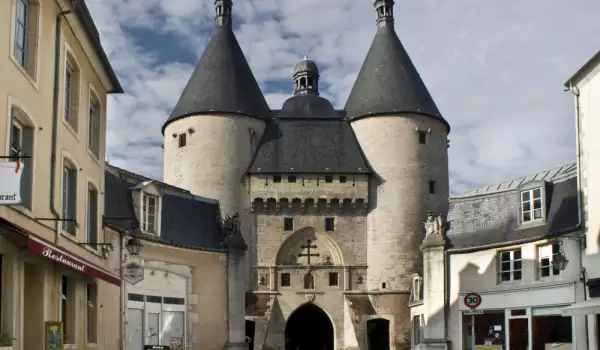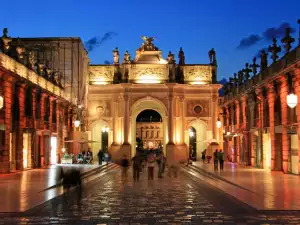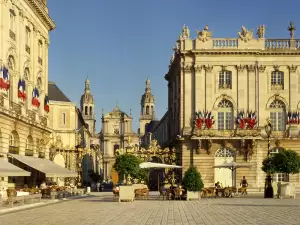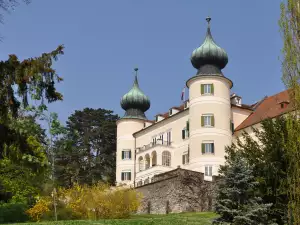Nancy

Nancy is a French town in the region Meurthe-et-Moselle. The city was an acting duchy of Lorraine. Nancy is the administrative center of the region. In the city live about 104 000 people. Nancy's motto is a Latin phrase that means "Nobody can hurt me with impunity", the symbol of Lorraine is the thistle.
At the point where today the city of Nancy is, there were people eight hundred years BC. In 1050 a settlement was founded, called Nanciacum.
In the eleventh century Gérard I de Lorraine built a sumptuous castle in Nancy. It became a favorite place for a pleasant stay for the French aristocracy. Nancy not only has a castle, which has high walls, but at that time a Mint was made.

At the beginning of the thirteenth century during the war for power in the Holy Roman Empire Nancy was captured by the Emperor Frederick II and burnt down. After the city was rebuilt, it became the capital of the duchy of Lorraine. After full recovery of the city, it was protected by a new gorgeous castle. During the reign of the Third Duke Ferry III, Nancy played an important role in the history of Lorraine. At that time the town got its first constitution.
At the end of the fifteenth century Nancy faces the threat of loss of independence and inclusion in the domain of the powerful dukes of Burgundy. One of them, Charles the Bold, captured Nancy in 1476. In the famous battle of Nancy in 1477, Charles the Bold, died after being beaten by the Swiss- Lorraine troops. This battle ended the long struggle of the French kings with the Dukes of Burgundy, who opposed the unification of the French regions.
After the Battle of Nancy, Charles the Bold’s possessions were divided and the Duchy of Burgundy became the possession of the French king, and the Netherlands became part of the possessions of the Habsburg dynasty.
At the end of the sixteenth century, Nancy developed as an industrial city. Here was built the new city, which borders Old Town. At that time, in the city and its environs were built many villas of aristocrats.
In the seventeenth century Nancy suffered a period of decline due to the foreign policy of France, which seeks to expand its borders to the east. By 1660 the town was under the control of the royal troops. In 1697 duchy of Lorraine again gained its independence. In 1729, they lost it again.
After the death of the last Duke - Stanislas, the duchy became a French province. The city is a monument of Stanislas, who ruled duchy for thirty years. Stanislas receives lifetime tenure in Lorraine, provided that he renounces the Polish crown. After this move, the duchy fell under the domination of France and Stanislas became something of a Governor, who was preparing for integration into the French Kingdom.

In the twentieth century, Nancy was occupied by the Nazis in 1944 but was released after the Battle of Nancy. After years of expansion and gradually transforming, the city turned into a tourist destination. Tourists from around the world visit Nancy, to see the sites, concentrated in the old town. There are the cathedral of Nancy and other beautiful examples of architecture from the eighteenth century. The city has a large botanical garden, and a fairly large aquarium.
North of the cathedral of Nancy is Stanislas Square. It was built by Emmanuel Héré in 1760. Around the square there are five sumptuous palaces with amazing balconies. In the center of the square is a statue of King Stanislas. There are the fountains Neptune and Amphitrite and the sculptures of Barthélemy Guibal.
Near the government palace is located the demographic former palace built in 1544 and renovated in 1871. This is the most magnificent building in the city from the late Gothic period. It is richly decorated with three balconies.
In the demographic Palace is the historical museum of Lorraine. There are archaeological artifacts and a rich collection of everyday objects from the history of Lorraine. The museum has a rich collection of antique tapestries.
The city has a massive Gothic church - the church St. Epvre. The church tower rises eighty-seven meters.
In a workshop for crystal objects in Nancy, tourists can see the details of how to produce objects of glass.
In the southeastern part of town is a small but beautiful church from the Baroque period. It is called Notre-Dame de Bon-Secours. There is also the tomb of King Stanislas, and the mausoleum of his wife - Catherine Opalińska.







